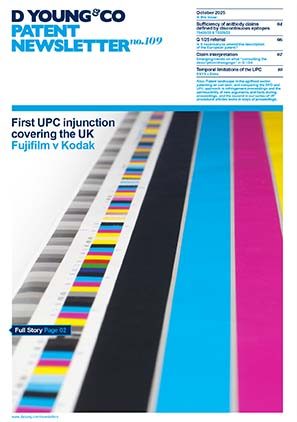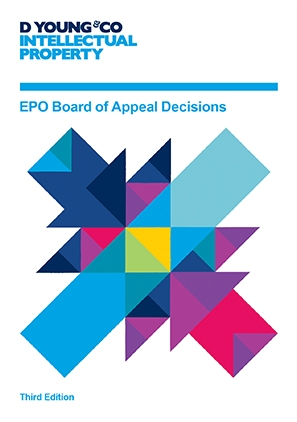T 1989/18: adaptation of the description of a European patent application
Prior to grant of a European patent application, examiners often request the description to be adapted for consistency with the subject matter of the allowable set of claims. This became a more onerous exercise following an update to the EPO Guidelines for Examination in March 2021, which set out a significantly greater range of circumstances in which the description should be adapted. A recent decision from an EPO Board of Appeal considered whether there was legal basis for refusing an application if the description was not adapted to the subject matter of the claims.
Background
Section F-IV, 4.3 of the EPO Guidelines for Examination concerns inconsistencies between the description and the claims. It states that any inconsistency between the description and the claims must be avoided if it may throw doubt on the extent of protection and therefore render the claim unclear or unsupported under Article 84 EPC (clarity and conciseness).
An appeal was lodged in 2018 following the examining division’s decision to refuse the application. The examining division found the set of claims to be allowable, but that amendments made to the description did not meet the requirements of Article 84 EPC. The amendments consisted of insertions of the wording “In one embodiment of the invention”. The examining division considered the amended description to relate to subject-matter which was broader than the subject-matter of the allowable claims, and took the view that the scope of protection was unclear.
Section F-IV, 4.3 (iii) of the EPO Guidelines for Examination was updated in 2021 to reflect the wording of an earlier decision (T 1808/06) which states that, in order to meet the requirement of Article 84 EPC, “[r]eference to embodiments no longer covered by amended claims must be deleted, unless these embodiments can reasonably be considered to be useful for highlighting specific aspects of the amended subject-matter. In such a case, the fact that an embodiment is not covered by the claims must be prominently stated.” This updated wording has caused numerous communications to be issued by the EPO where only the adaptation of the description has been required in response.
The decision
The Board of Appeal considered various parts of the EPC that might give rise to the legal requirement for amending the description.
Article 84 EPC states “The claims shall define the matter for which protection is sought. They shall be clear and concise and be supported by the description.”
The Board of Appeal observed that Article 84 EPC only mentions the description in the context of the additional requirement that it must support the claims; the requirements of clarity and conciseness only apply to the claims. The Board of Appeal decided that the set of claims of the appealed application were clear in themselves and supported by the description. As a result, the clarity of the claims is not affected if the description contains subject-matter which is not claimed, and therefore the requirements of Article 84 EPC are met.
The Board of Appeal also considered Rules 42(1)(c) and 48(1)(c) EPC. Rule 42(1)(c) EPC requires that the description discloses the invention in such terms that the technical problem and its solution can be understood. Here, the Board of Appeal decided that the passages of the description objected to by the examining division do not impair the understanding of the technical problem and its solution as set forth elsewhere in the description, and therefore that the requirements of Rule 42(1)(c) EPC were met.
Rule 48(1)(c) EPC requires that a European patent application shall not contain any statement or other matter obviously irrelevant or unnecessary under the circumstances. Here, the Board of Appeal noted that the purpose of Rule 48 EPC as a whole is to prevent the publication of matter contrary to morality or public order, and that there is a general acceptance that an application should not be refused even if the application as filed contained such matter. The wording of Rule 48 EPC suggests an order of offensiveness for such matter, with obviously irrelevant or unnecessary matter being ranked the lowest. As Rule 48 EPC is silent on any legal consequences for an application containing obviously irrelevant or unnecessary matter, the Board of Appeal decided that the purpose of Rule 48(1)(c) EPC cannot be to keep a patent specification free of unnecessary information and to make sure that its content relates only to what protection is sought, and therefore that Rule 48 EPC cannot serve as a legal basis for the refusal.
The Board of Appeal therefore decided that there are no legal provisions of the EPC to refuse an application where embodiments disclosed in the description are of a more general nature than the subject-matter of an independent claim.
Analysis
This decision contradicts the earlier decision (T 1808/06) on which the current wording of the EPO Guidelines is based. In T 1808/06, the opponent appealed the decision to maintain the patent in amended form on the grounds that an inconsistency between the claims and the description and drawings gave rise to objections under Article 84 EPC. Here, the Board of Appeal decided that the description must be adapted in order for the claims to be supported by the description.
In contrast, the present decision states that the claims are supported by the description simply by the subject matter of the claims being present in the description. Indeed, the present decision suggests that subject matter in the description can be referred to as “embodiments of the invention” even if it falls outside the scope of the claims. This is surprising, since Boards of Appeal are supposed to refer cases to the enlarged Board of Appeal where there is a deviation of law.
It is clear that the features of the independent claims must be present in the description in order for the claims to be supported, but other requirements as to the content of the description under Article 84 EPC are unclear.
A number of previous decisions have relied on Rule 48(1)(c) EPC as a legal basis for requiring the description to be adapted to the subject-matter as claimed. Indeed, section F-IV, 4.4 of the EPO Guidelines states that claim-like clauses must be deleted from the description because they lead to a lack of clarity as to the scope of protection, and are irrelevant and unnecessary and therefore contravene Rule 48(1)(c) EPC. This decision implies that there is also no legal provision of the EPC to object to claim-like clauses in the description.
Conclusion
This decision will be welcomed by many parties, as adapting the description can be a time-consuming exercise and the updated wording of the EPO Guidelines for Examination has resulted in additional communications being issued by the EPO, slowing down examination proceedings. This decision appears to provide legal basis for resisting large scale adaptation of the description in order for an application to proceed to grant.
The 2022 update of the EPO Guidelines for Examination will come into effect in March 2022. A dedicated workshop regarding the adaptation of the description was held in November 2021, with a follow-up meeting planned, so an update to this section of the EPO Guidelines for Examination was already being considered. We therefore await with interest now to see how the 2022 EPO Guidelines for Examination will be updated in view of this decision.


